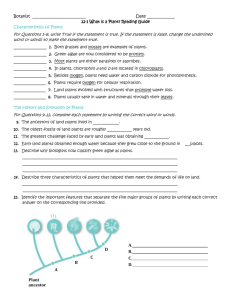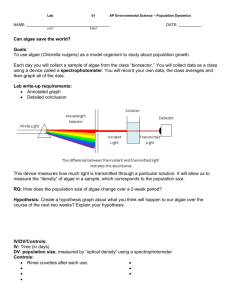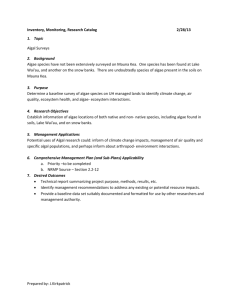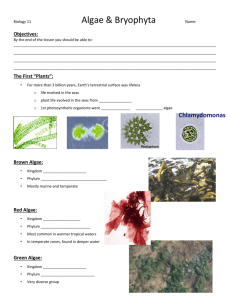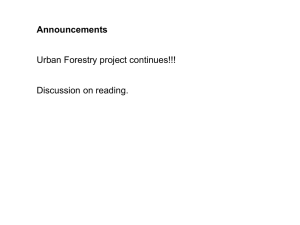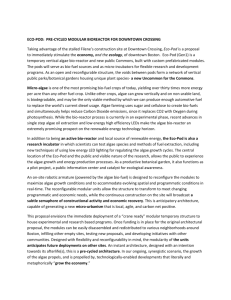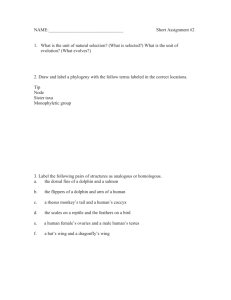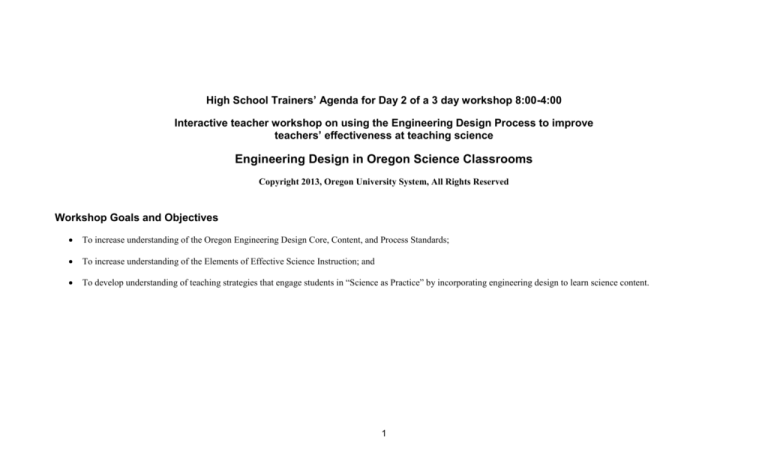
High School Trainers’ Agenda for Day 2 of a 3 day workshop 8:00-4:00
Interactive teacher workshop on using the Engineering Design Process to improve
teachers’ effectiveness at teaching science
Engineering Design in Oregon Science Classrooms
Copyright 2013, Oregon University System, All Rights Reserved
Workshop Goals and Objectives
To increase understanding of the Oregon Engineering Design Core, Content, and Process Standards;
To increase understanding of the Elements of Effective Science Instruction; and
To develop understanding of teaching strategies that engage students in “Science as Practice” by incorporating engineering design to learn science content.
1
Day Two – High School
Time
Total: 10 min
8:00-8:10:
Opening (slides 12)
(10 min)
Activity
Unit One – Welcome Back and Overview
Introductions – Facilitators/Participants
Workshop Goals (on slide and poster)
Logistics – description of baskets
Expectations (Hopes)
Bike Rack
Credit Information
Workshop and Folder Overview
Group Norms
Day 2 Agenda review (slide)
Explain dots & #s on name tags
Facilitator Notes
Lead
1)
2)
3)
Please share: Your name, Your
grade level, Your school, What you
hope to get out of the training
4)
5)
6)
In Folder:
Agenda
Welcome participants to the EDP PD.
Facilitators Introductions.
Participants introduce themselves:
7)
8)
9)
10)
11)
12)
13)
Facilitator explains the goals of the
workshop.
Facilitator then discusses the
housekeeping includes restroom
locations, manage your needs, & site
specific information.
Expectations (Hopes) – have table
groups discuss expectations and
share out.
Explain the Bike Rack and posters in
the room.
Credit info
Workshop and folder overviews.
Basket supplies
Facilitator leads discussion to obtain
the group agreements (such as cell
phones, respecting other
opinions/ideas, basic needs, side
conversations and comments,
respect others and have fun.
Agenda review
Explain dots & #s on name tags
Materials
Main Room:
Laptop Computer
LCD Projector
Speakers
EDP Facilitator’s Folder
Folder:
Agenda
Training Kit:
PPT
Agenda
Supplies:
EDP Posters
Agenda
Folders
Sign-in Roster
Name Tags
Markers & Chart pack
Baskets with
highlighters
post it notes
toys
Resource Books
Biofuel From Algae Full
Lesson Plan
Littlefoot’s Ride Full Lesson
Plan
Posters:
Goals
Agenda
Bike Rack (by coffee)
Expectations
2
Set-up
Before Session:
Hang standards posters,
set out participant folders,
& baskets
Post Workshop Goals &
Agenda written on poster
Post Bike Rack, Name tag
dots & #s, Expectations,
and Group Agreements
charts
Sign in & Name Tags out
Resource Books, Primers
and Full lesson plans for
Biofuel From Algae and
Littlefoot’s Ride on Table
Breakout Rooms:
Laptops, projectors,
and speakers
Posters, chart packs,
and markers
Set up a laptop in main
room with a timer for us.
Time
Activity
Lead
Facilitator Notes
Materials
Group Agreements/Norms
Name tag dots & #s
Standards
Essential Skills
Science Inquiry and the EDP
Total: 95 min –
8:10-9:45
8:10-9:00
Commingling Core
and Content
drawing and
carousel
(30 min)
In Folder:
1) Activity Instructions (Pages 4-5
in Training Materials Day 2 file)
2) HS ED Standards Handout
3) Loose Blank Paper
8:40-9:00
EDP for HS
(20 min)
9:00-9:25
What students
should learn about
the process
(20 min)
9:25-9:45
Sharing and
Cleanup (20 min)
How the engineering-design process applies to
teaching and learning science in high school
Index Card Chair Activity
In Folder:
1) Activity Instructions (Pages 6-8
in Training Materials Day 2 file)
2) HS ED Standards Handout
3) EDP for HS
4) Index Card Chair Challenge
Sheets
Commingling Core and Content
Activity
1) 8:10 - Group participants in groups of
2-3.
2) As a group, participants will draw or
sketch a representation of the Core
and Content Standards that go along
with the high school standards (15
minutes).
3) 8:30 - When each group has finished
creating their picture or series of
pictures, have them complete a Core
and Content Standards Tour
(carousel).
4) Each small group will rotate to the 5
other stations (5 minutes each).
5) At each station, participants will
review the Core and Content
Standards for each grade level.
6) Rotating groups will provide feedback
with sticky notes.
7) Groups review feedback (5 minutes).
Participant Folder:
Loose blank paper
HS ED Core and Content
Standards
EDP Process for HS
What the students should learn about
the process (9:00)
1) Show the Slide, “The Engineering
Design Process for High School” to have
a quick reference on the engineering
design process. For more detailed
descriptions of the process, review
the High School Primer.
2) 9:05 - Tell participants that they’ll be
working in pairs to design a chair that
can support the weight of an apple,
orange or soda can out of index cards
only – no tape is allowed.
Participant Folder:
EDP Process for MS
Index Card Chair Challenge
Sheet
3
Training Kit:
PPT
Supplies:
Pencils and Markers
Tape to hang pics on chart
packs
Chart Packs
Training Kit:
PPT
Supplies:
Pencils and Markers
Set-up
Time
Activity
Facilitator Notes
Lead
3)
4)
5)
6)
7)
8)
9:45-10:00
Break
(15 min)
Total: 105 min
10:00 – 10:40
Presenting and
Completing the
lesson (40 min)
10:40-11:00
Sharing and
Cleanup (20 min)
BREAK
Unit 2 – Biofuel From Algae
Hands-on exercise featuring the Engineering
Design process for learning Life Science
1)
In Folder:
Biofuel From Algae Full Lesson Plan
2)
11:00-11:25
Scientific Inquiry vs
the EDP (25 min)
3)
11:25-11:45 Small
Group Discussion
(20 min)
4)
5)
6)
Materials
Hand out the Index Card Chair
Challenge Sheet.
Have participants brainstorm two
chair designs.
Keep the participants on time. Give a
few minutes of warning when the
activity is about to end.
After the participants have built their
chair, line the chairs up side by side
on a table and see which chairs can
hold the designated object.
9:25 – Have participants reflect on
designing their chair and share what
they feel students should learn about
the engineering design process.
Have participants create a list on
chart packs and share out
Participants take a break
Index Cards (6/group)
Scissors
apple, orange or soda can
Chart Packs
10:00 Introduce the lesson, allow
participants to read the Algae Article,
show them your prototype, and have them
sketch it on the Algae Machine Workshop
Handout.
Within their groups, teachers should
identify current problems for the initial
prototype. Discuss ideas with the
participants using the Algae Machine
Design Worksheet for Teachers handout
as a reference.
Using the Algae Machine Data Worksheet
for the initial prototype, participants should
study this data and determine the optimal
set-up values for an algae machine.
Have participants evaluate the validity of
the results and determine what kinds of
further testing would be useful as they
redesign the initial prototype.
Have them write down their ideas and
discuss answers with all participants using
the Algae Machine Design for Teachers
handout as a reference.
Teachers should identify both the
constraints of their redesigns as well as
the trade-offs they will need to negotiate in
their redesigns. Discuss ideas using the
Folder:
Biofuel From Algae Handouts
(Algae Article, Algae Machine
Design Handout for Teachers,
and Algae Data Worksheet.)
4
Training Kit:
PPT
Algae Machine Demo with
grown algae
Set-up
Build your algae machine
demonstration/prototype
and grow your algae before
the workshop
Time
Activity
Facilitator Notes
Lead
7)
8)
9)
10)
11)
12)
13)
14)
15)
Algae Machine Design Worksheet for
Teachers handout as a reference.
Review the data collection methods
available and have participants practice by
collecting initial data on up to three
bottles.
Have participants complete the Algae
Machine Design Handout
Working in their groups, participants
should sketch a redesign of the algae
machine prototype in the space provided
on their Algae Machine Design Handout.
They should label their sketches and in
the space to the right, create a list of its
design features such as its starting
solution ratio of algae to fertilizer as well
as the amount of light algae will receive
per day.
Arrange participants into groups of six.
Each pair within the group should share
their design sketch with the other two
pairs. The entire group should then
evaluate the designs using criteria,
constraints, and trade-offs and decide
which of the three possibilities is the most
promising.
10:40 Have participants share what they
have learned. Ask about things they will
have noticed or had difficulty with
Summarize main idea on chart pack (15
min)
11:00 Group Discussion: Scientific Inquiry
vs. the Engineering Design Process.
Groups use flip charts to answer 3
questions (6 min per question) on p13. (20
min)
Summarize the project, and reflect on the
discussion questions as well as the
overarching messages about using the
engineering design process to improve the
teaching of science (5 minutes).
11:25 Small group discussion on
implementing the EDP into their lesson
plans or grade band level.
Total 45 min
11:45 – 12:30
LUNCH
Individual Reflection or Team Planning Time
5
Materials
Set-up
Time
Total: 90 min
12:30- 2:00
12:30 – 1:25
Presenting and
Completing the
lesson (45 min)
1:25-1:45
Discussion and
Cleanup (15 min)
Activity
Unit 3 – Littlefoot’s Ride
Hands-on exercise featuring the Engineering
Design process for learning Physical Science
In Folder:
Littlefoot’s Full Lesson Plan
Materials
Facilitator Notes
Lead
In groups of 3-4, have participants use the
engineering design process to design the
fastest car.
1)
2)
3)
4)
5)
6)
7)
12:30 - Have participants read the Roller
Coaster Physics 101 article and show
them the pre-established track as well as
the prototype cart and both prototype hills.
12:35 - Have them sketch everything in
the Littlefoot’s Lil Coaster Workshop
Handout.
12:40 - Demonstrate how to calculate PE
and have participants practice.
12:45 - Have participants complete the
handout.
12:55 - Using the data set, have
participants design, build, test and
recommend solution prototypes.
1:25 - Have participants share what they
have learned. Ask about things they will
have noticed or had difficulty with
Summarize main ideas on chart pack (10
min)
1:40 - Summarize the project, and reflect
on the discussion questions as well as the
overarching messages about using the
engineering design process to improve the
teaching of science (5 minutes).
Folder:
Handouts (Roller Coaster
Physics 101 article,
Littlefoot’s Lil’ Coaster
Workshop, Littlefoot’s
Design Worksheet,
Littlefoot’s Data Worksheet,
and Lil’ Coaster Initial Data
Set)
Training Kit:
PPT
Supplies:
Duct tape, masking tape,
scissors, glue, cardstock, pennies,
sandpaper, handsaws and any
other construction tool you want
the participants to have the option
of using
Gram scale
Supplies per Group
Regular sized and small craft
sticks
Straws
Toothpicks
Lego 20 pulley wheel
Lego Cross Axels size 4M
Thomas & Friends
Trackmaster Bridge Expansion
Pack - FisherPrice
Thomas & Friends
6
Set-up
Before the workshop, using
the Lil’ Coaster Lesson Setup Instructions create a
prototype cart and two hills
On a counter or table-top,
lay out the materials you
have available for the cart
and hill prototypes. Also put
out masking tape, scissors,
glue, cardstock pennies,
sandpaper, handsaws and
any other construction tool
you want the participants to
have the option of using.
Time
Activity
Lead
Facilitator Notes
Materials
Set-up
Trackmaster Straight & Curved
Track Pack – FisherPrice
Stop watches or timers
1:45-2:00
Troubleshooting as an opportunity for learning
science
Short presentation followed by discussion
2:00-2:15
BREAK
Formative Assessment of Engineering Design
process
Participants take a break
Total: 60 min
2:15-3:15
2:15-2:20
2:20-2:50
Participants form small groups to go over a set
of questions (handout) relating to formative
assessment of students understanding of the
steps in engineering design.
Teachers develop answers to questions
on handout.
None
Training Kit:
PPT
Handout on formative
assessment
Distribute Chart pack
paper and markers to table
groups.
Supplies: None
Pens
Go through slides that have the same
questions and ask for input from each
group on each question. Encourage
discussion
2:50-3:15
Total: 60 minutes
3:15-4:15
Divide participants into groups of 2-4
participants
Training Kit:
PPT
Supplies: None
Using Engineering Design in Your Classroom
3:15-3:45
Have teachers break into groups and
Choose a lesson that they
currently teach using science
inquiry or otherwise
Discuss how engineering design
could be used
Use flipchart to capture
o Ideas
o Issues
Take about 30 minutes
Training Kit:
PPT
Supplies
Markers & Chart pack
Report out – 5 minutes per group
Discuss as a group what patterns and
issues were observed
3:45-4:05
4:05-4:15
Total 15 Min
Closure Activities:
Bike Rack (check may share out in the
Facilitator reviews items on the bike rack.
7
Supplies:
Post it notes
Debrief pluses and Wishes
at end of the day.
Time
Activity
4:15-4:30
morning)
Goals
Review expectations
Expense claim forms?
Pluses/Wishes
Lead
Facilitator Notes
Review goals and expectations. Have
table groups discuss the expectations.
See if they are the same now or if they
would like to add any.
Participants write 2 pluses about the PD
that day and 2 wishes that they had on
post-it and turn in when they leave.
8
Materials
Set-up

